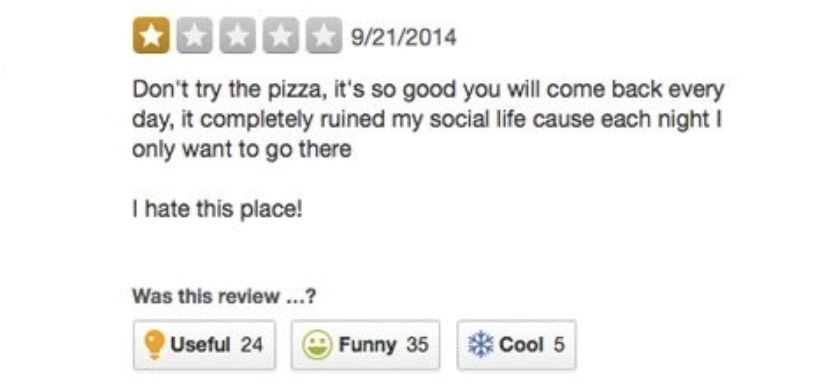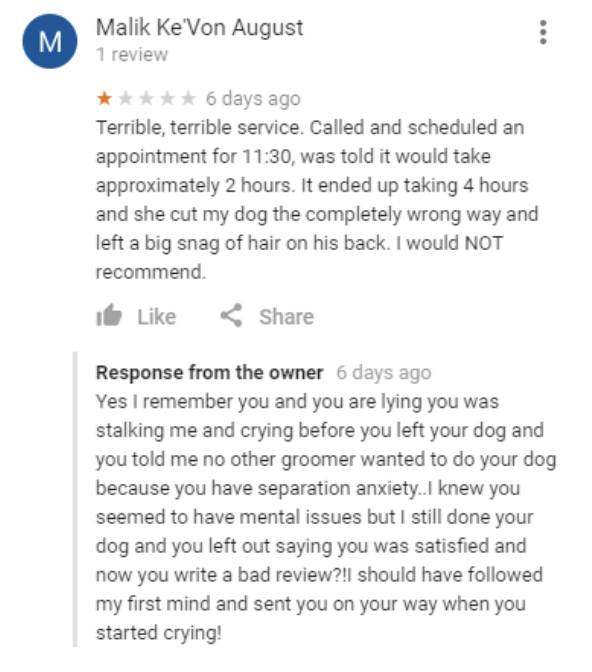Negative reviews hurt, especially after all the time and efforts growing your business, but in today’s age, no business can expect 100% positive online feedback. There will always be some customers unhappy with a product, service, or interaction with your business. At the same time, negative reviews can actually benefit your business, especially when they offer genuine, constructive criticism, suggestions for improvement, and you respond to negative reviews
Today, 9 out of 10 customers read online reviews before making a purchase. Many even search for negative feedback to identify if there low risk if something goes not as planned or any potential “red flags” from previous customers, clients, or employees.
Another thing people look for, is how businesses respond to negative feedback. A proactive, understanding, and positive response can show potential customers that you provide support with care about improving and resolving issues, which can improve your business reputation, attract new customers, and boost sales. And yes, people actually read business responses, according to survey, 93% respondents read what business replied to review.

Understanding the Psychology Behind Negative Reviews
Before we discuss how to address bad reviews and respond to them, let’s dive deep into psychology behind negative reviews, who writes them, and how people read and respond to them.
Negative reviews have significant psychological influence over consumer behavior towards your business. It is estimated that negative reviews can lower web traffic and cause over 30% loss in revenue.
Studies in consumer behavior show that negative experiences leave a deeper impression than positive ones. This disparity leads dissatisfied customers to write negative reviews seven times more frequently and more likely than satisfied ones. Remarkably, a single negative review can carry more weight than forty positive ones. This phenomenon, called “negativity bias”, highlights how people are more inclined to remember and be affected by negative events and feedback.
Managing and trying to respond to negative reviews becomes crucial for protecting business reputation against the psychological effects of negative online reputation.
Need Help on How to Respond to Negative Reviews?

We help businesses in managing and responding to reviews online. Learn more about our online reputation management services.
Common Types of Negative Online Reviews
Negative online reviews can be categorized in different ways, often depending on the type of the complaint, the tone of the review, reviewer intent, and even the person writing style and personality. Here are some common types of negative online reviews:
- Product or Service Complaints. Reviews focusing on defects, malfunctions, poor product, not right expectations or capabilities.
- Customer Service and Support Complaints. Reviews mentioning poor interactions with employees or problems not being addressed satisfactorily or timely. Can describe complex interactions, misinterpretations, disagreements, policy complaints, service delivery, or simply someone having a bad day.
- Delivery and Logistics Complaints. Reviews focusing on items arriving later than expected, wrong address, broken, or in poor condition, or complaints about receiving the wrong or incomplete order.
- Value for Money Complaints. Reviews stating that the product or service is not worth the cost or comments about charges that were not expected, poor transparency in pricing or expectations.
- Misleading Advertising. Complaints about products or services not living up to promotional materials or what being promised.
- User Experience Complaints. Comments about difficult ordering or service processes or reviews focusing on technical issues or poor design.
- Cleanliness and Maintenance Complaints. Concerns about cleanliness issues, health related, safety, poorly maintained facilities or equipment.
- Wait Time Complaints. Reviews mentioning excessive waiting times and delays for service, delivery, or support.
- Policy, Returns, and Refunds Complaints. Comments about unfair, or not being able, or difficult to return, get refund, or exchange.
- Experience-Based Complaints. Reviews focusing on the reviewers dissatisfaction, can be reasonable or unreasonable, sometimes subjective. Also, comments influenced by anger, frustration, or disappointment.
- Spam or Malicious Reviews. Bad actors writing misleading reviews, often posted by competitors, disgruntled employees, spammers, scammers, people promoting other services, and “trolls” that leave comments meant to provoke or upset rather than provide constructive feedback.
In conclusion, understanding the various types of negative online reviews helps businesses navigate and address customer feedback effectively. It gives opportunities to leave the review as is and try to respond, or flag and report it if the review violates network’s community guidelines and rules.
What Types of Reviews Raise “Red Flags” Among Customers?
People are generally reasonable, if a negative review doesn’t raise serious concerns, they are still likely to make a purchase. For example, a lack of return policy can be a major issue, but dissatisfaction with a product’s color is often seen as a personal preference and can even reassure potential buyers that the product itself is fine. The same applies to the travel and restaurant industries. Issues like bed bug infestations or food poisoning are major red flags for most customers. However, complaints about how the food tastes or the view from the window are usually not as concerning to potential customers.
Me personally, I still booked the hotel even after finding that most negative reviews were about unrelated construction across the street. While it was indeed noisy during the daytime, I wasn’t planning to spend much time there during daylight hours anyway. No one mentioned noise at night, and the hotel itself was exceptional, therefore, negative reviews didn’t affect my choice and assured me that nothing else wrong with my booking decision.
Which Negative Reviews Should Companies Address and Respond To?

When customers research businesses and product they want to purchase, it’s important for them to find diverse opinions from previous customers, including negative reviews that offer constructive feedback without raising major concerns. Even better if business publicly responded to these reviews providing transparency and a commitment to improvement. According to study, 90% of customers more likely to overlook a negative review is business responded, and 93% people read business responses to reviews. Also, negative reviews often don’t hurt sales when they are outweighed by positive feedback, strong online reputation, and an overall high ratings across various networks.
Most customers value reading diverse opinions about businesses, and a few negative reviews can help them to prepare for potential issues without necessarily affecting their final purchasing decision. In fact, if a well established business doesn’t have any negative reviews, it might raise suspicions and questions about transparency or attempts to hide critical feedback.
Which Negative Reviews Should Be Flagged and Reported?
While some negative reviews can stay and actually benefit your business, others should be flagged and reported for several reasons:
First, reviews that are clearly fake, written by competitors, spammers, scammers, or generated by bots should be flagged immediately. These reviews often lack any real interaction with your business, product, or service and can mislead potential customers and clients. Same way, reviews that contain hate speech, offensive language, or personal attacks should be reported for violating community guidelines of review networks.
Secondly, reviews that are irrelevant to the product or service offered by the business should be flagged as well. This includes spammy content, off-topic remarks, or reviews that discuss unrelated issues. Such reviews can clutter the platform and make it harder for customers to find real feedback that helps them make informed decisions. Sometimes even positive reviews can provide no value, for example someone wrote not genuine review just to get a reword or incentive from the review network.
Thirdly, reviews that are authentic and genuine but written in a tone or contain information that still violates the network’s rules and guidelines. For example, a former employee can use inappropriate language or talk badly about a manager or supervisor disclosing job title or even name.
Lastly, reviews written by competitors or people with a conflict of interest should also be flagged and removed. These reviews often trying to damage a business reputation rather than provide genuine feedback based on experience.
Need Help Flagging and Removing Negative Reviews?

We assist businesses on how to report and respond to negative reviews about their company. Payment is only required upon successful confirmation of removal.
Best Practices on Responding to Negative Online Reviews
Responding to negative reviews online is important for maintaining your business reputation and demonstrating your commitment to customer satisfaction.
Here are some steps to follow and mistakes to avoid when replying to negative reviews:
- Stay Professional and Calm. No matter how bad or ridiculous the review, approach the response professionally when trying to respond to negative reviews. Avoid being defensive or argumentative. Keep in mind that your response is not only for the reviewer who shared negative feedback online but also for all future customers who will read it as well.
- Keep it Brief and to the Point. Maintain focused response, address the key points of the review without going into too much detail.
- Acknowledge the Concern. Start by thanking the reviewer for their feedback and acknowledging their issue. Express empathy and understanding of their unfortunate experience.
- Apologize Sincerely. Even if the issue not even your fault, offer a genuine apology for any inconvenience or negative experience they had. A simple “We’re really sorry to hear about your experience” can be a great opening line for your reply.
- Provide a Solution and Next Steps. Explain how you are going to address the issue and how you plan to prevent it in the future. Let the reviewer know if a follow up is required.
- Encourage Further Communication. Invite the reviewer to discuss the matter further offline, support, email, or chat.
- Learn and Improve. Use the feedback to make necessary improvements to your business, products, services, or operations.
Optimal Response Times for Business Reviews
When customers leave bad reviews, they are often expressing frustration or dissatisfaction with the product purchased or service provided. Responding fast provides businesses an opportunity to address these issues while they are still top of mind. Delaying a response can prolong customer disappointment and reflect poorly on the company’s customer service. In today’s competitive environment, people expect fast responses and resolutions. It is recommended to reply as soon as possible, ideally within 24 hours. And waiting longer than 48 hours risks missing the opportunity window to resolve the customer’s concerns effectively and maybe even making them to take down the review.
In addition, failing to respond to reviews can even impact sales and the perception of future customers who research businesses before making a purchasing decision.
Here is a great example how fast response can make it right. On Twitter, a customer complained that the AC in a local coffee shop was too strong and making it uncomfortably cold. The social media manager monitoring the restaurant’s account saw it and called the shop and requested they adjust the temperature. Moments later, the manager replied to the customer’s tweet with a one word “Done!” The customer was pleasantly shocked and deeply appreciative that the issue was addressed so quickly while she was still at the shop, enjoying her coffee.
Mistakes to Avoid When Writing Replies to Negative Reviews
When response goes wrong. Example of reply that breaks all the rules of professional conduct and shows how not to respond to negative reviews:

Some mistakes in responding to online reviews can escalate the situation, make it worse, and show future customers lack of support and understanding when dealing with issues and concerns.
- Being Too Defensive or Argumentative. Avoid responding defensively or even arguing with the reviewer. This can escalate the situation and backfire.
- Ignoring the Review or Concerns Presented. Don’t ignore negative reviews. Not responding makes it seem like you don’t care about customer feedback and improving.
- Not Acknowledging the Issue. Failing to acknowledge the reviewers concerns can come off as dismissive. Make sure to read carefully, understand the problem and recognize the issue they raised before offering a solution.
- Using Generic Language. Avoid copy and paste generic responses. Personalized replies show that you value each customer’s feedback.
- Using AI or Bots for Responses. Over time, people have learned to distinguish between genuine writing and content generated by AI platforms.
- Not Apologizing. Even when the issue wasn’t your fault at all, offering a sincere apology shows empathy and a commitment.
- Writing Long Responses. Keep your response concise and focused. Long writings can dilute your message and lose the reader’s interest.
- Not Providing a Solution. Not only apologizing, but offering a clear solution or explanation will show proactive steps to resolve the situation.
- Taking Too Long to Reply. Delayed responses can frustrate the reviewer further and suggest a lack of interest and urgency to their concerns.
- Using Dismissive or Negative Language. Avoid using negative, aggressive, dismissive, or sarcastic language. Keep it professional in your replies even if the reviewer seem not rational or unreasonable.
- Not Being Professional. Stay professional even when getting unreasonable, rude, or ridiculous feedback.
- Lying, Avoiding Answers, and Blaming Others. Take the ownership for the response, don’t try to blame others like vendors, partners, distributors. And never try to avoid answers or lie.
- Publicly Discussing Sensitive Details. Avoid discussing sensitive or personal details publicly. Offer to take the conversation offline to protect the reviewer’s privacy and handle the issue more effectively.
- Don’t Reply to Fake Reviews. And don’t do any of the steps above for fake Reviews. All fake reviews should be flagged and reported. You might be tempted to leave a sarcastic reply to such reviews, but future customers may not understand your tone and might mistake the fake review for a genuine one, thinking you are responding negatively to a legitimate complaint.
By avoiding these mistakes, you can write effective replies when trying to respond to negative reviews that demonstrate your commitment to customer satisfaction and help maintain your business online reputation.
Why Businesses Should Avoid Responding to Fake Reviews
Now, when it comes to fake reviews. The best way to handle them is to report them right away and get them removed.
Responding to fake reviews can be more harmful than beneficial for many reasons. Replying to a fake review can inadvertently add it legitimacy, making it appear credible to others, it will also add value to it and potentially move it higher on a review network or search engines. When a business replies, it might signal to potential customers that the review has some merit, even if it’s totally fake. This unintentional validation can give more weight to the fake review, potentially causing some customers to leave.
Public responses to fake reviews are also prone to misinterpretation. A reply can be taken out of context or perceived as confrontational, further harming the business image and reputation. Also, replying to fake reviews can escalate the situation, especially if it’s a competitor or if someone is attempting to extort money. In such cases, the individual behind the fake review might retaliate with even more bad fake reviews and replies, creating a prolonged conflict.
Ignoring fake reviews and concentrating on positive and genuine customer interactions is often a better strategy. By doing so, businesses can maintain a mature professional image and avoid coming across as defensive or insecure in a way. You should also trust people’s rationality, many of them can sense which reviews genuine and which ones are fake.
Leaving Funny Replies to Negative Feedback. Is it Recommended?

Occasionally, responding with humor or wit to social posts or negative feedback can be effective, but caution is advised because it carries risk. Avoid emotional reactions and consider asking professional advice before posting your funny reply. In addition, try to maintain a respectful tone, even when faced with absurd ridiculous feedback or comments.
Example on How to Reply to Negative Reviews. How to Address Criticism Effectively
Here some examples of writing perfect responses to negative online reviews. Remember to use the best practices provided above and avoiding common mistakes.
Example of Standard Reply to a Negative Review:
“Thank you for your feedback, [Reviewer’s Name]. We are sorry to hear about your experience and appreciate you bringing this to our attention. We’d like to make it right for you. Please reach out directly at [contact information] and we can discuss how to resolve this. Your satisfaction is important to us, and we hope to have the opportunity to serve you better.”
Example of Shorter Reply to a Negative Review:
“Thank you, [Reviewer’s Name], for your feedback. We are sorry for your experience and appreciate for bringing this to our attention. Please contact us at [contact information] so we can discuss resolving this. We value your opinion and hope to serve you better in the future.”
Example of Reply to B2B Related Negative Review:
“Thank you, [Reviewer’s Name], for your feedback. We apologize for your experience and appreciate you raising this issue. Please reach out to us directly at [contact information] so we can work together to resolve this matter. Your satisfaction is our priority, and we look forward to improving our service for you in the future.”
Example of Reply to Negative Review Regarding Shopping Experience:
“Thank you for your feedback regarding your recent shopping experience with us. We are sorry to hear about your dissatisfaction and appreciate you bringing this to our attention. Please reach out to us directly at [contact information] so we can address and assist you better. Your satisfaction is important to us, we are committed to improving your experience in the future.”
Example of Reply to Negative Review Regarding Restaurant or Dining Experience:
“Thank you for your feedback regarding your recent dining experience. We are deeply sorry to hear about your disappointment and appreciate you bringing this to our attention. Please contact us directly at [contact information] so we can address and resolve this issue promptly. Your satisfaction is important to us, and we are committed to improving your experience with us in the future.”
Example of Reply to Negative Review Regarding Hotel or Lodging Experience:
“Thank you for your feedback regarding your stay with us. We apologize for any dissatisfaction you experienced during your visit and appreciate you letting us know. Please reach out to us directly at [contact information] so we can address your concerns promptly. Your satisfaction is our priority, and we are dedicated to improving your experience with us in the future.”
Example of Reply to Negative Review Regarding Service Provided:
“Thank you for your feedback regarding our service provided. We apologize for any issues you experienced and appreciate you letting us know. Please contact us directly at [contact information] so we can address your concerns. Your satisfaction is our priority, and we are committed to improving our service to ensure a better experience for you in the future.“
Example of Reply to Negative Review Regarding Product Quality
“Thank you for your feedback regarding [product purchased]. We apologize for any disappointment you experienced with the product and appreciate you bringing this to our attention. Please contact us directly at [contact information] so we can address your concerns promptly. Your satisfaction is important to us, and we are committed to improving our products to meet your shopping expectations”
Example of Response Reply to Negative Review Regarding Customer Service Experience and Interaction:
“Thank you for your feedback regarding your recent customer service experience. We apologize for any issues you encountered and appreciate you bringing this to our attention. Please contact us directly at [contact information] so we can address your concerns promptly. Your satisfaction is important to us, and we are committed to improving our customer service experience in the future.”
By applying these examples when responding to reviews, you can effectively address negative feedback and hopefully convert a dissatisfied customer into a loyal one.
Need Assistance on How to Reply and Respond to Negative Reviews?

We specialize in assisting businesses with managing and responding to online reviews. Discover more about our comprehensive online reputation management services.
Why Hiring RetainTrust for Review Management and Responses Is Beneficial
Hiring RetainTrust to manage and respond to your reviews can significantly benefit your business and improve sales. With our experience, we understand the most effective approaches for handling both positive and negative feedback online. Every insight and advice shared in this blog post is derived from our experience working with our clients, and we are ready and happy to apply these strategies to improve your business reputation as well.
Many businesses struggle to reply to reviews fasty due to resource limitations. It’s crucial to reply within 24 hours, preferably within 48 hours, to address concerns and demonstrate your commitment to customer satisfaction. If you reply too late, you lose the window of opportunity to resolve the issue and turn negative reviews into your advantage. RetainTrust acts fast as your assistant and reputation management partner, making sure to provide timely responses and proactive engagement to protect your brand.




